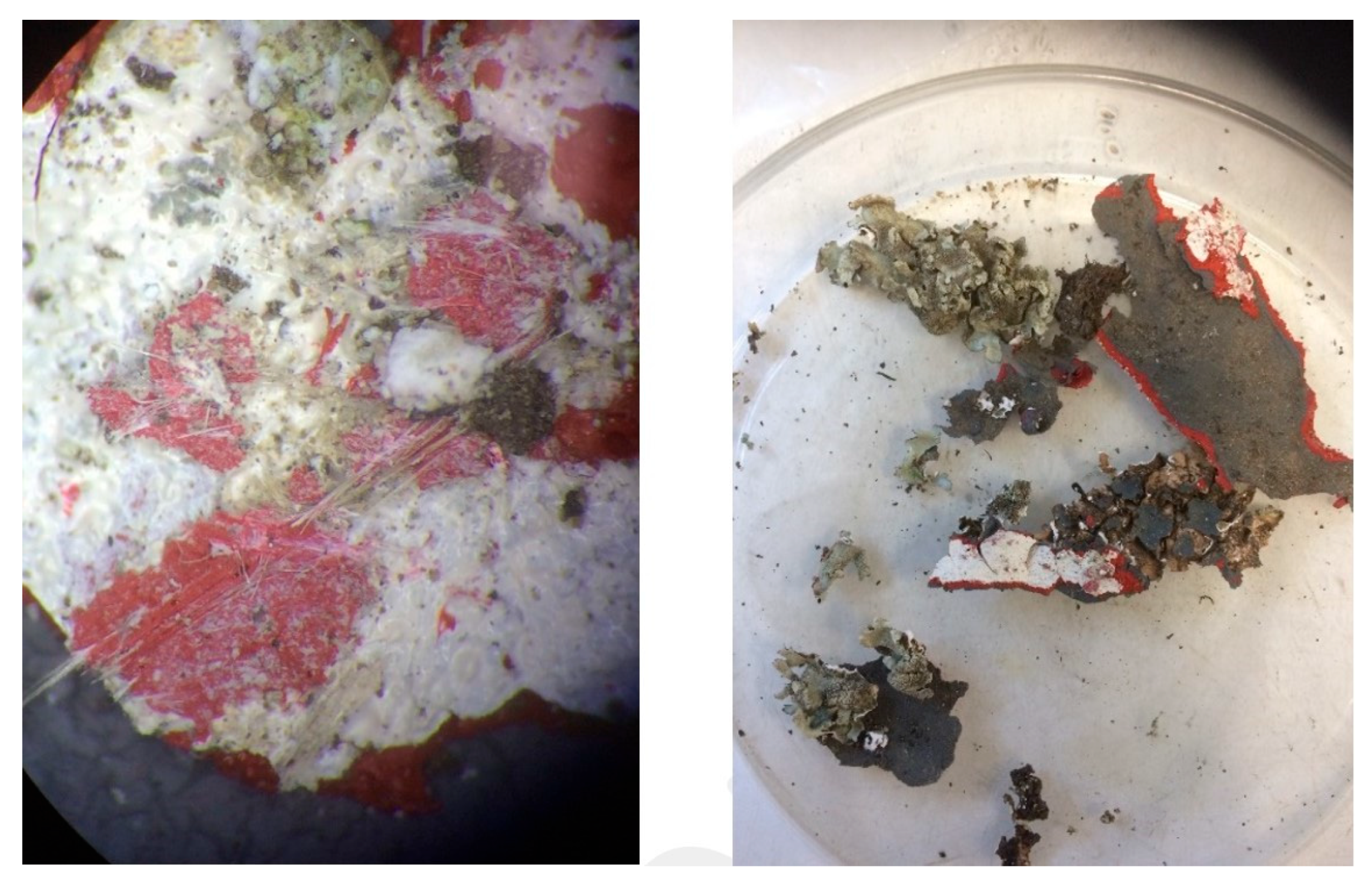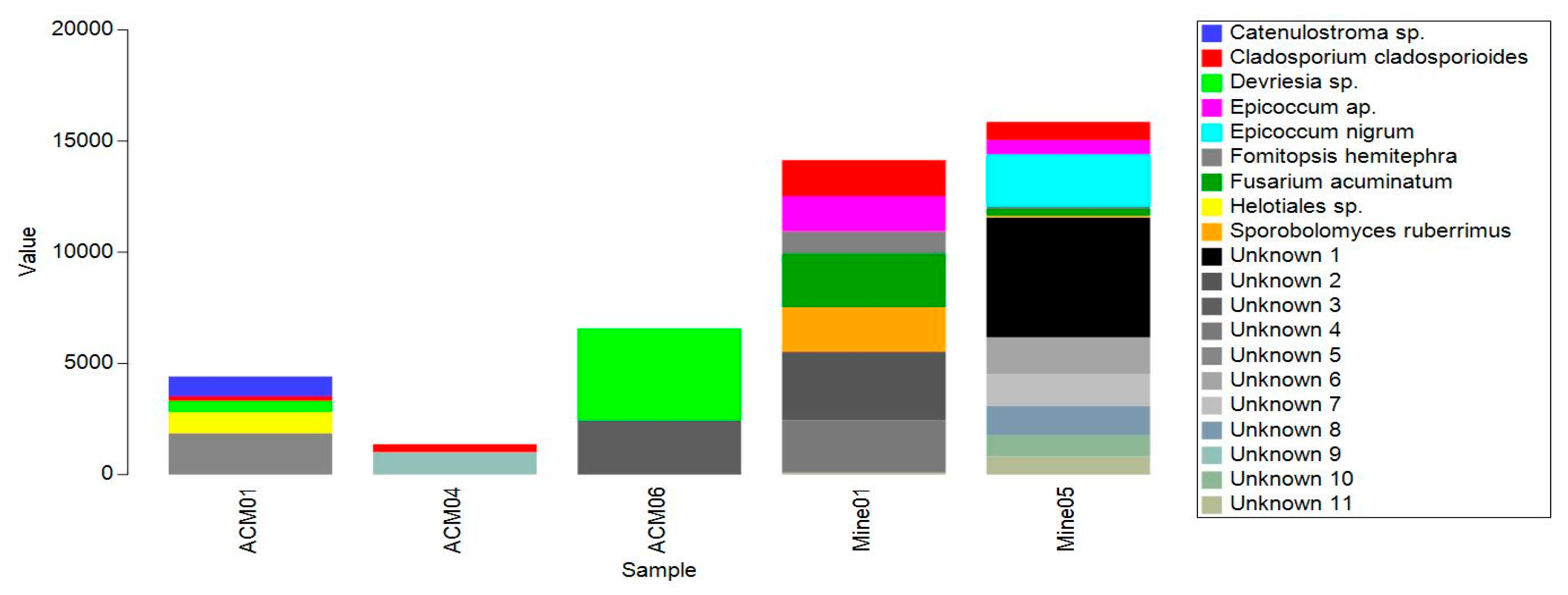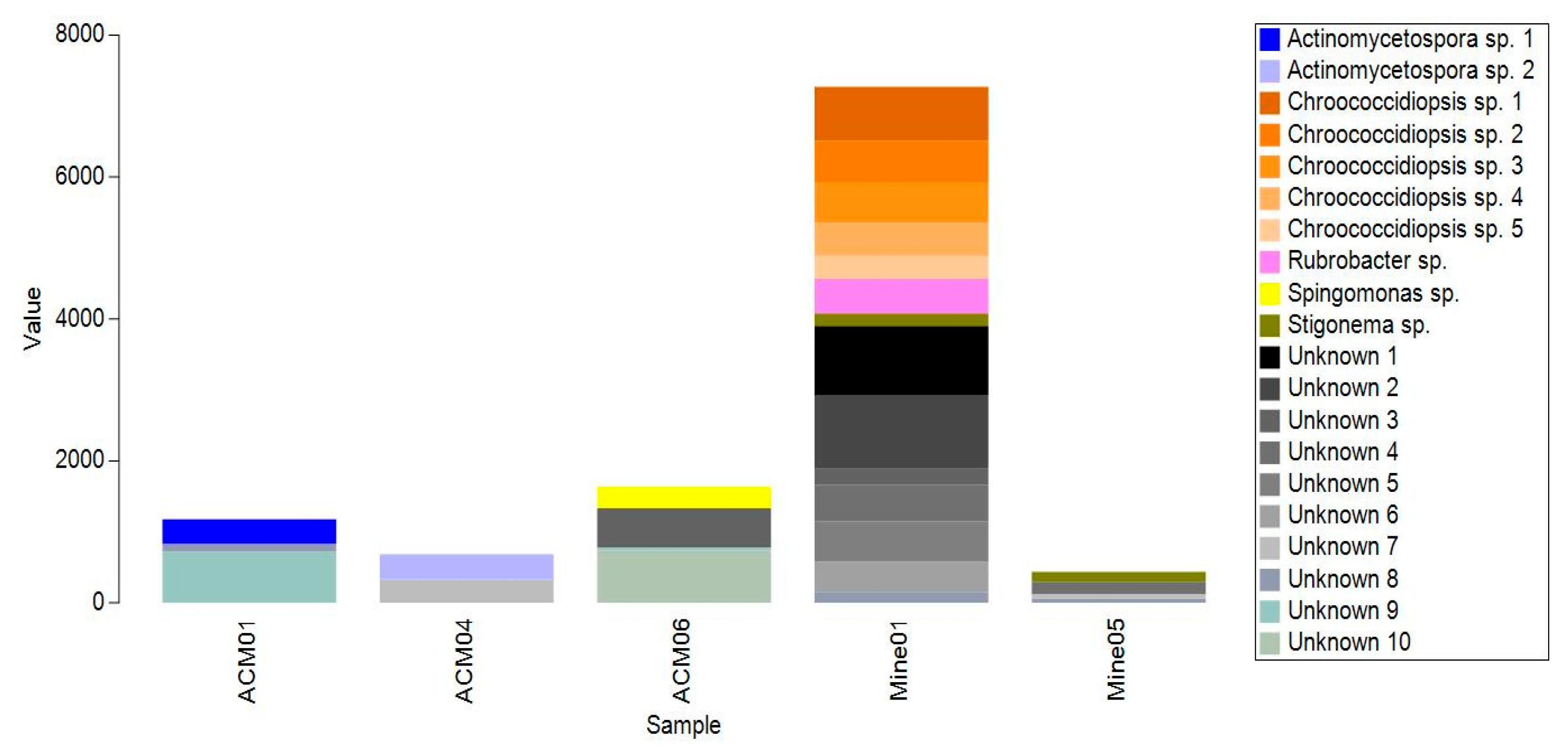A Preliminary Investigation into the Degradation of Asbestos Fibres in Soils, Rocks and Building Materials Associated with Naturally Occurring Biofilms
Abstract
:1. Introduction
2. Materials and Methods
2.1. Asbestos Identification and Biofilm Sampling Procedures
2.1.1. Natural Deposits
2.1.2. Asbestos-Containing Materials
2.1.3. Asbestos Contaminated Soils
2.2. Asbestos Fibre Identification
2.3. Asbestos Fibre Characterisation
2.4. Identification of Organisms Found in Association with Asbestos-Containing Materials
2.4.1. DNA Extraction and 16S and ITS Amplicon Sequencing
2.4.2. Culturing of Fungi and DNA Barcoding
2.5. Health and Safety
3. Results
3.1. Asbestos Characterisation and Fibril Modification
3.1.1. Lichen Material from ACM Samples and ACM Samples
3.1.2. Asbestos from Serpentinite Rocks
3.1.3. Asbestos Contaminated Soils
3.2. Microbial Identification
3.2.1. Lichen Material Taken from ACM Samples
3.2.2. ACM Samples
3.2.3. Asbestos Bundles from Serpentinite Rock
3.2.4. Asbestos Contaminated Soils
4. Discussion
5. Conclusions
Author Contributions
Funding
Data Availability Statement
Acknowledgments
Conflicts of Interest
References
- Kumar, S.; Chiemchaisri, C.; Mudhoo, A. Bioreactor landfill technology in municipal solid waste treatment: An overview. Crit. Rev. Biotechnol. 2011, 31, 77–97. [Google Scholar] [CrossRef] [PubMed]
- Wallis, S.; Lemckert, C.; Hardy, R.; Berry, T.A. Disposal or Treatment: Future considerations for solid waste from the construction and demolition industry. In WIT Transactions on Ecology and the Environment; Wessex Waste Management: Southhampton, UK, 2020; Volume 247, pp. 171–183. [Google Scholar]
- National Institute for Occupational Safety and Health (NIOSH). Asbestos Fibers and Other Elongate Mineral Particles: State of the Science and Roadmap for Research, Revised Edn., Department of Health and Human Services, DHHS (NIOSH) Publication No. 2011–159, 2011, Current Intelligence Bulletin, 62, 1–159. Available online: https://www.cdc.gov/niosh/docs/2011-159/default.html (accessed on 16 November 2022).
- Jablonski, R.P.; Kim, S.J.; Cheresh, P.; Kamp, D.W. Insights into mineral fibre-induced lung epithelial cell toxicity and pulmonary fibrosis. In Mineral Fibres: Crystal Chemistry, Chemical-Physical Properties, Biological Interaction and Toxicity; Mineralogical Society: Washington, DC, USA, 2017; pp. 447–500. [Google Scholar]
- Vigliaturo, R.; Jamnik, M.; Dražić, G.; Podobnik, M.; Žnidarič, M.T.; Ventura, G.D.; Redhammer, G.J.; Žnidaršič, N.; Caserman, S.; Gieré, R. Nanoscale transformations of amphiboles within human alveolar epithelial cells. Sci. Rep. 2022, 12, 1782. [Google Scholar] [CrossRef]
- Lai, H.; Hu, C.; Qu, M.; Liu, X.; Xue, Y.; Xu, P.; Hao, D. Mesothelioma due to Workplace Exposure: A Comprehensive Bibliometric Analysis of Current Situation and Future Trends. Int. J. Environ. Res. Public Health 2023, 20, 2833. [Google Scholar] [CrossRef]
- World Health Organization (WHO). Chemical Safety and Health—Asbestos. Available online: https://www.who.int/teams/environment-climate-change-and-health/chemical-safety-and-health/health-impacts/chemicals/asbestos (accessed on 20 October 2020).
- Berry, T.-A.; Belluso, E.; Vigliaturo, R.; Giere, R.; Emmett, E.A.; Testa, J.R.; Steinhorn, G.; Wallis, S.L. Asbestos and Other Hazardous Fibrous Minerals: Potential Exposure Pathways and Associated Health Risks. Int. J. Environ. Res. Public Health 2022, 19, 4031. [Google Scholar] [CrossRef] [PubMed]
- Wallis, S.L.; Emmett, E.A.; Hardy, R.; Casper, B.B.; Blanchon, D.J.; Testa, J.R.; Mendes, C.W.; Gonneau, C.; Jerolmack, D.J.; Seiphoori, A.; et al. Challenging Global Waste Management—Bioremediation to Detoxify Asbestos. Front. Environ. Sci. 2020, 8, 20. [Google Scholar] [CrossRef] [PubMed]
- Government of Western Australia Department of Health. Guidelines for the Assessment Remediation and Management of Asbestos-Contaminated Sites in Western Australia; Government of Western Australia, Department of Health: Perth, Australia, 2009.
- Spasiano, D.; Pirozzi, F. Treatments of asbestos containing wastes. J. Environ. Manag. 2017, 204, 82–91. [Google Scholar] [CrossRef]
- Favero-Longo, S.E.; Turci, F.; Tomaits, M.; Castelli, D.; Bonfante, P.; Hochella, M.F.; Piervittori, R.; Fubini, B. Chrysotile asbestos is progressively converted into non-fibrous amorphous material by the chelating action of lichen metabolites. J. Environ. Monitor. 2005, 7, 764–766. [Google Scholar] [CrossRef]
- Favero-Longo, S.E.; Girlanda, M.; Honegger, R.; Fubini, B.; Pievittori, R. Interactions of sterile-cultured lichen forming ascomycetes with asbestos fibres. Mycol. Res. 2007, 111, 473–481. [Google Scholar] [CrossRef]
- Daghino, S.; Turci, F.; Tomatis, M.; Favier, A.; Perotto, S.; Douki, T.; Fubini, B. Soil fungi reduce the iron content and the DNA damaging effects of asbestos fibers. Environ. Sci. Technol. 2006, 40, 5793–5798. [Google Scholar] [CrossRef]
- Favero-Longo, S.E.; Siniscalco, C.; Piervittori, R. Plant and lichen colonization in an asbestos mine: Spontaneous bioattenuation limits air dispersion of fibres. Plant Biosyst. 2006, 140, 190–205. [Google Scholar] [CrossRef]
- Daghino, S.; Martino, E.; Vurro, E.; Tomatis, M.; Girlanda, M.; Fubini, B.; Perotto, S. Bioweathering of chrysotile by fungi isolated in ophiolitic sites. FEMS Microbiol. Lett. 2008, 285, 242–249. [Google Scholar] [CrossRef]
- Mohanty, S.K.; Gonneau, C.; Salamantipour, A.; Pietrofesa, R.A.; Casper, B.; Christofidou-Solomidou, M.; Willenbring, J.K. Siderophore-mediated iron removal from chrysotile: Implications for asbestos toxicity reduction and bioremediation. J. Hazard. Mater. 2018, 341, 290–296. [Google Scholar] [CrossRef] [PubMed]
- Daghino, S.; Martino, E.; Fengolio, I.; Tomatis, M.; Perotto, S.; Fubini, B. Inorganic materials and living organisms: Surface modifications and fungal responses to various asbestos forms. Chem.-Eur. J. 2005, 11, 5611–5618. [Google Scholar] [CrossRef] [PubMed]
- Martino, E.; Prandi, L.; Fenoglio, I.; Bonfante, P.; Perotto, S.; Fubini, B. Soil fungal hyphae bind and attack asbestos fibers. Angew. Chem. 2003, 115, 229–232. [Google Scholar] [CrossRef]
- AS 4964-2004; Method for the qualitative identification of asbestos in bulk samples. Standards Australia: Sydney, Australia, 2004.
- Rice, S.B.; Treacy, M.M.J.; Newsam, J.M. Shear faults in Lovelock ferrierite. Zeolites 1994, 14, 335–343. [Google Scholar] [CrossRef]
- Arletti, R.; Fantini, R.; Giacobbe, C.; Gieré, R.; Vezzalini, G.; Vigliaturo, R.; Quartieri, S. High-temperature behavior of natural fer-rierite: In-situ synchrotron X-ray powder diffraction study. Am. Mineral. 2018, 103, 1741–1748. [Google Scholar] [CrossRef] [PubMed]
- Giacobbe, C.; Wright, J.; Dejoie, C.; Tafforeau, P.; Berruyer, C.; Vigliaturo, R.; Gieré, R.; Gualtieri, A.F. Depicting the crystal structure of fibrous ferrierite from British Columbia using a combined synchrotron techniques approach. J. Appl. Cryst. 2019, 52, 1397–1408. [Google Scholar] [CrossRef]
- Schindelin, J.; Arganda-Carreras, I.; Frise, E.; Kaynig, V.; Longair, M.; Pietzsch, T.J.; Preibisch, S.; Rueden, C.; Saalfeld, S.; Schmid, B.; et al. Fiji: An open-source platform for biological-image analysis. Nat. Methods 2012, 9, 676–682. [Google Scholar] [CrossRef]
- HSE. Asbestos: The Analysts’ Guide for Sampling, Analysis and Clearance Procedures (HSG248), 2nd ed.; Health and Safety Executive: Sheffield, UK, 2021.
- Op De Beek, M.; Lieven, B.; Busschaert, P.; Declerck, S.; Vangronsveld, J.; Colpaert, J. Comparison and validation of some ITS primer pairs useful for funal metabarcoding studies. PLoS ONE 2014, 9, e97629. [Google Scholar]
- Walters, W.; Hyde, E.; Berg-Lyons, D.; Ackerman, G.; Humphrey, G.; Parada, A.; Gilbert, J.; Jansson, J.; Caporaso, J.; Fuhrman, J.; et al. Improved bacterial 16S rRNA gene (V4 and V4-5) and fungal internal transcribed spacer marker gen primers for microbial community surveys. mSystems 2015, 1, e00009-15. [Google Scholar] [CrossRef]
- Morgan, M.; Anders, S.; Lawrence, M.; Aboyoun, P.; Pagès, H.; Gentleman, R. ShortRead: A Bioconductor package for input, quality assessment and exploration of high-throughput sequence data. Bioinformatics 2009, 25, 2607–2608. [Google Scholar] [CrossRef]
- Callahan, B.J.; McMurdie, P.J.; Rosen, M.J.; Han, A.W.; Johnson, A.J.A.; Holmes, S.P. DADA2: High-resolution sample inference from Illumina amplicon data. Nat. Methods 2016, 13, 581–583. [Google Scholar] [CrossRef]
- Gardes, M.; Bruns, T.D. ITS primers with enhanced specificity for basidiomycetes—Application to the identification of mycorrhizae and rusts. Mol. Ecol. 1993, 2, 113–118. [Google Scholar] [CrossRef] [PubMed]
- White, T.J.; Bruns, T.D.; Lee, S.B.; Taylor, J.W. PCR Protocols: A Guide to Methods and Applications; Innis, M.A., Gelfand, D.H., Sninsky, J.J., White, T.J., Eds.; Academic Press: San Diego, CA, USA, 1990; pp. 315–322. [Google Scholar]
- International Accreditation New Zealand (IANZ). Asbestos-Surveying, Inspection, Sampling & Testing: Supplementary Criteria for Accreditation, AS LAB C2.3/AS IB C1.1, 3rd ed.; IANZ: Auckland, New Zealand, 2021.
- Bjelland, T.; Grube, M.; Hoem, S.; Jorgensen, S.L.; Daae, F.L.; Thorseth, I.H.; Øvreås, L. Microbial metacommunities in the lichen–rock habitat. Environ. Microbiol. Rep. 2011, 3, 434–442. [Google Scholar] [CrossRef]
- Spribille, T.; Tuovinen, V.; Resl, P.; Vanderpool, D.; Wolinski, H.; Aime, M.C.; Schneider, K.; Stabentheiner, E.; Toome-Heller, M.; Thor, G.; et al. Basidiomycete yeasts in the cortex of ascomycete macrolichens. Science 2016, 353, 488–492. [Google Scholar] [CrossRef] [PubMed]
- Vero, S.; Garmendia, G.; González, M.B.; Bentancur, O.; Wisniewski, M. Evaluation of yeasts obtained from Antarctic soil samples as biocontrol agents for the management of postharvest diseases of apple (Malus× domestica). FEMS Yeast Res. 2013, 13, 189–199. [Google Scholar] [CrossRef] [PubMed]
- Frederick, C.B.; Szaniszlo, P.J.; Vickrey, P.E.; Bentley, M.D.; Shive, W. Production and isolation of siderophores from the soil fungus Epicoccum purpurascens. Biochemistry 1981, 20, 2432–2436. [Google Scholar] [CrossRef]
- Macara, G.R. The Climate and Weather of Nelson and Tasman. NIWA Science and Technology Series; NIWA: Auckland, New Zealand, 2016; Volume 71, 40p. [Google Scholar]
- Doyle, E.; Blanchon, D.; Wells, S.; de Lange, P.; Lockhart, P.; Waipara, N.; Manefield, M.; Wallis, S.; Berry, T.A. Internal transcribed spacer and 16s amplicon sequencing identifies microbial species associated with asbestos in New Zealand. Genes 2023, 14, 729. [Google Scholar] [CrossRef]
- Ahmed, E.; Holmström, S.J. Siderophore production by microorganisms isolated from a podzol soil profile. Geomicrobiol. J. 2015, 32, 397–411. [Google Scholar] [CrossRef]
- El-Maraghy, S.S.; Tohamy, T.A.; Hussein, K.A. Expression of SidD gene and physiological characterization of the rhizosphere plant growth-promoting yeasts. Heliyon 2020, 6, e04384. [Google Scholar] [CrossRef]
- Borges, R.; Klaic, R.; Sanchez Farinas, C.; Ribeiro, C. Biological treatment of asbestos cement wastes by Aspergillus niger and Acidithiobacillus thiooxidans. Appl. Clay Sci. 2022, 216, 106375. [Google Scholar] [CrossRef]
- Obmiński, A.; Janeczek, J. The effectiveness of asbestos stabilizers during abrasion of asbestos-cement sheets. Constr. Build. Mater. 2020, 249, 118767. [Google Scholar] [CrossRef]
- Webber, J.S.; Blake, D.J.; Ward, T.J.; Pfau, J.C. Separation and Characterization of Respirable Amphibole Fibers from Libby, Montana. Inhal. Toxicol. 2008, 20, 733–740. [Google Scholar] [CrossRef] [PubMed]









| TEM Sample Identifier | Contents | IANZ Analysis | Observations | DNA Sample Code |
|---|---|---|---|---|
| NZ_A_01 | ACM Roof fragment | Chrysotile/Amosite | Presence of cement/concrete-derived material on fibre surfaces/boundaries. Minor evidence of fibre surface modification. | ACM01 |
| NZ_A_04 | ACM Shed Cladding | Chrysotile/Amosite | Presence of cement/concrete-derived material on fibre surfaces/boundaries. Minor evidence of fibre surface modification. | - |
| NZ_A_06 | Lichen material from ACM | Chrysotile/Amosite | Presence of cement/concrete-derived material on fibre surfaces/boundaries. Minor evidence of fibre surface amorphisation/modification. | - |
| NZ_A_07 | Lichen material from ACM | Chrysotile | Presence of cement/concrete-derived material on fibre surfaces/boundaries. Minor evidence of fibre surface amorphisation/modification. | ACM04 |
| Q-00036, S3-3 | Asbestos contaminated soil | Chrysotile | Minor evidence of fibre surface amorphisation/modification. Al-based phases related to the soil present | - |
| Q-00036, S1-020 | Asbestos contaminated soil | Chrysotile | Minor evidence of fibre surface amorphisation/modification. Al-based phases related to the soil present | - |
| Q-00036, S2-013 | Asbestos contaminated soil | Chrysotile | Minor evidence of fibre surface amorphisation/modification. Al-based phases related to the soil present | - |
| S-09884, S1-RS01 | ACM -Base cladding fragment | Chrysolite/Amosite | Presence of cement/concrete-derived material on fibre surfaces/boundaries. Minor evidence of fibre surface amorphisation/modification. | ACM06 |
| S-10146-S1.1 | Chrysotile mine sample | Chrysotile | Pristine fibres with some signs of surface modification in rare cases | Mine01 |
| S-10146-S4.5 | Chrysotile mine sample | Chrysotile | Pristine fibres with some signs of surface modification in rare cases | Mine05 |
Disclaimer/Publisher’s Note: The statements, opinions and data contained in all publications are solely those of the individual author(s) and contributor(s) and not of MDPI and/or the editor(s). MDPI and/or the editor(s) disclaim responsibility for any injury to people or property resulting from any ideas, methods, instructions or products referred to in the content. |
© 2024 by the authors. Licensee MDPI, Basel, Switzerland. This article is an open access article distributed under the terms and conditions of the Creative Commons Attribution (CC BY) license (https://creativecommons.org/licenses/by/4.0/).
Share and Cite
Berry, T.-A.; Wallis, S.; Doyle, E.; de Lange, P.; Steinhorn, G.; Vigliaturo, R.; Belluso, E.; Blanchon, D. A Preliminary Investigation into the Degradation of Asbestos Fibres in Soils, Rocks and Building Materials Associated with Naturally Occurring Biofilms. Minerals 2024, 14, 106. https://doi.org/10.3390/min14010106
Berry T-A, Wallis S, Doyle E, de Lange P, Steinhorn G, Vigliaturo R, Belluso E, Blanchon D. A Preliminary Investigation into the Degradation of Asbestos Fibres in Soils, Rocks and Building Materials Associated with Naturally Occurring Biofilms. Minerals. 2024; 14(1):106. https://doi.org/10.3390/min14010106
Chicago/Turabian StyleBerry, Terry-Ann, Shannon Wallis, Erin Doyle, Peter de Lange, Gregor Steinhorn, Ruggero Vigliaturo, Elena Belluso, and Dan Blanchon. 2024. "A Preliminary Investigation into the Degradation of Asbestos Fibres in Soils, Rocks and Building Materials Associated with Naturally Occurring Biofilms" Minerals 14, no. 1: 106. https://doi.org/10.3390/min14010106






